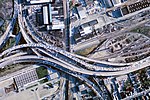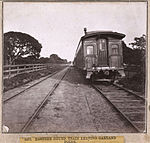West Oakland Yards
Properties of the Union Pacific RailroadRail transportation in Oakland, CaliforniaRail yards in CaliforniaTransportation buildings and structures in Alameda County, CaliforniaUnited States rail transportation stubs

The West Oakland Yards are a rail yard facility in West Oakland, Oakland, California, in the United States. Formerly a major facility for the Southern Pacific Railroad, the yards have been operated by Union Pacific Railroad since 1996. Under SP, the yards were home to a variety of railroad facilities, including a signal shop and a creosoting plant.SP was said to "dominate" West Oakland with its "massive switching and maintenance yards, roundhouses, car assembly and repair shops, creosoting plant, and shipyards".
Excerpt from the Wikipedia article West Oakland Yards (License: CC BY-SA 3.0, Authors, Images).West Oakland Yards
Tulagi Street, Oakland West Oakland
Geographical coordinates (GPS) Address Nearby Places Show on map
Geographical coordinates (GPS)
| Latitude | Longitude |
|---|---|
| N 37.818 ° | E -122.298 ° |
Address
Tulagi Street
Tulagi Street
94608 Oakland, West Oakland
California, United States
Open on Google Maps





